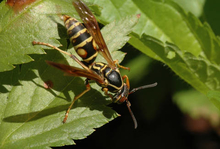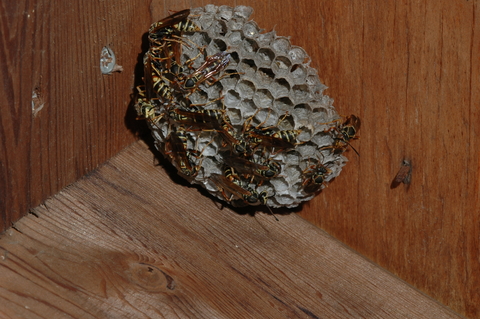
Identifying Bees and Wasps and their Nests
By BJ Hansell, Dakota County Master Gardener
There it is. The buzzing noise that strikes fear into the hearts of many a gardener. It might be nothing more than a hummingbird zipping by. Or maybe, just maybe, It’s a stinging insect. It’s a bee, a wasp a hornet! Duck and run!! Truly, most of the time if you leave these creatures alone, they will leave you alone. After all, they are only protecting their territory. They are wonderful pollinators, and you do love how well your garden is flourishing. Hmmm, let’s take a closer look at them & their homes.

There it is. The buzzing noise that strikes fear into the hearts of many a gardener. It might be nothing more than a hummingbird zipping by. Or maybe, just maybe It’s a stinging insect. It’s a bee, a wasp a hornet! Duck and run!! Truly, most of the time if you leave these creatures alone, they will leave you alone. After all, they are only protecting their territory. They are wonderful pollinators, and you do love how well your garden is flourishing. Hmmm, let’s take a closer look at them and their homes. Read on to begin our busy journey.
This article is a very basic overview of the most commonly encountered wasp and bee nests in MN. You are encouraged to peruse the references provided. Indeed, count them as a launching pad into the amazing world of these insects, without which most of our gardens and agriculture fields would yield vacant lots and desolate landscapes.
Wasps and their nests:
Wasps will generally not bother people when their nests are not near human activity but should be eliminated when they are located close to people to minimize the risk of stings. Yellowjackets and paper wasps are two types of wasps commonly found in Minnesota.
Yellowjackets are 3/8” to 5/8” long and are bright yellow with black lines or other shaped markings on their abdomens. Their bodies are basically hairless and are hard and shiny. They can be mistaken for honey bees. Yellowjackets can be aggressive during late summer and fall around human food and drink.
Yellowjackets make their nests from a papery pulp made of chewed-up wood fibers mixed with saliva. Their nests may be found in many places: below ground in open cavities, hollow logs, and in voids in attics and walls. Some yellowjackets build nests in trees and under eaves of buildings. Hundreds to thousands of yellow jackets may be found inside these nests.
Paper wasps are ½ to 1 inch long and are usually brown with yellowish markings.
Paper wasp nests are small and can be found under any horizontal surface. In contrast with yellowjackets, not more than 100 wasps can be found in these nests. Neither yellowjackets nor paper wasps use their nests for more than one season.
Bees and their nests.
Honey bees and bumble bees are two types of bees commonly found in Minnesota. Bee nests are not usually a problem for humans and should be preserved when possible.
There are many different bumble bee species in Minnesota. Generally, bumble bees have the following characteristics: their size is less than one-half inch to one inch; they are fuzzy and round; and they are black and yellow.
Bumble bee nests are often found in underground cavities, under objects on the ground or higher up in trees or wall cavities. Their nests are made of wax.
Honey bees are about one-half inch long; are golden brown with thin black stripes on their abdomens and are fuzzy. Part of each hind leg is flat for collecting pollen.

Honey bee nests are the familiar vertical honeycombs made of wax. Their colonies are mostly found in manufactured hives although they occasionally nest in cavities of trees, buildings or similar structures.
Bees and wasps are complex and fascinating creatures that are vital to human existence. Although most of the time they will not bother humans, they can be aggressive if threatened. To feel more comfortable with these creatures, you would do well to learn all you can about them.
References:
https://extension.umn.edu/yard-and-garden-insects/wasps-and-bees
https://www.pollinatorsnativeplants.com/plant-lists--posters.html
Photo credits:
Photo 1, 5: en.wikipedia.org
Photo 2: 3,4: University of Minnesota Extension
Photo 6: Elaine Evans, University of Minnesota- Extension
Photo 7: Dalantech.deviantart.com (all creative commons)
Photo 8: Jeff Hahn, University of Minnesota Extension










